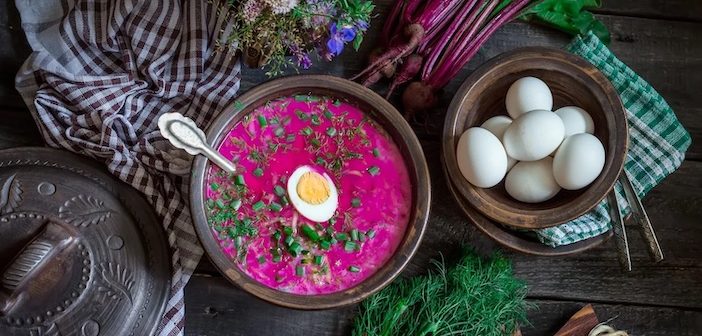“We chill the ants to make them sleepy,” explains the waiter, helpfully, “so that when we put them on top of your dessert they don’t run off…”
I exchange glances with the rest of the table, this is not how any of us expected to end what has been a superb tasting menu at one of Vilnius’s hippest restaurants, Nineteen18 set in Senatorių Pasažas, a historic mansion in the Lithuanian capital.
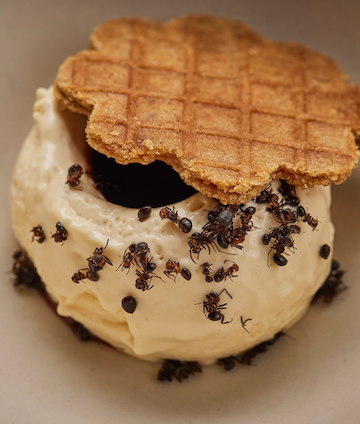 A ten course menu, it has consistently shown off Chef Andrius Kubilius’ innovative and inventive take on local and seasonal ingredients. The ants, presumably foraged from the surrounding countryside, or perhaps the restaurant’s own farm, are larger than normal ants, real Baltic bruisers.
A ten course menu, it has consistently shown off Chef Andrius Kubilius’ innovative and inventive take on local and seasonal ingredients. The ants, presumably foraged from the surrounding countryside, or perhaps the restaurant’s own farm, are larger than normal ants, real Baltic bruisers.
They are also now beginning to stir, so we eat the dish in one bite. There is a slight crunch amid the creaminess and then some salinity. That will be the ant, then.
We’ve already tried three pre-starters of veal brain; rikota and pike; and one of mushrooms, followed by mains of trout with tomato, fish stock and oscietra caviar, and then potato with sour cream, chickweed and pike caviar. There was also a carbonara, with the ‘spaghetti’ made from shaved white asparagus, and a dish of venison tartar dressed with a rich mushroom stock.
It’s all a long way from what I expected before flying out. I foresaw, as perhaps many do, a weekend spent eating meals heavy with meat, fat and root vegetables in dreary restaurants stuck in a Stalinist time warp.
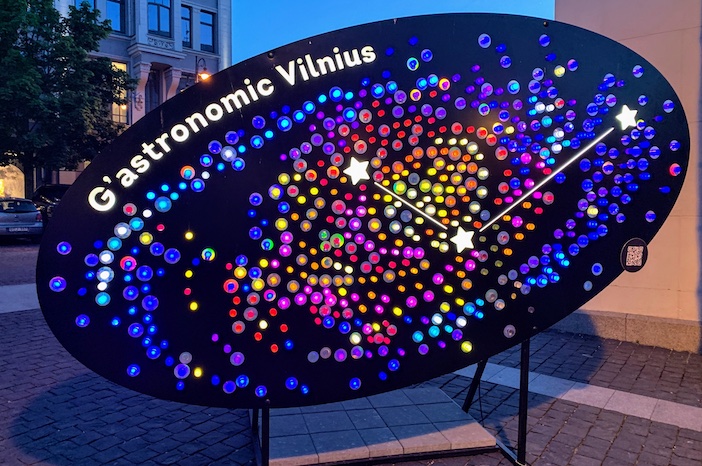
Of course, that’s a terrible cliche. In fact, Vilnius is a city that actually merits the word ‘vibrant’ when describing it, and that’ not UK estate agent speak for ‘might get mugged’. Two of its fine dining restaurants, Džiaugsmas and aforementioned Nineteen18, have been named among the top restaurants in the world in 2023 by the prestigious La Liste guide.
The narrow, winding streets of the beautiful medieval Old Town are packed with restaurants, bars, bakeries and coffee shops, and Vilnius’s young crowd always seem out in force radiating an optimism and energy you don’t see often in London. Porsches, Maseratis and Range Rovers slap their fat tyres over the cobbles, in the few streets where they are allowed to roll, with the youthful drivers all looking more like nerdy tech bros than nefarious mafiosi.
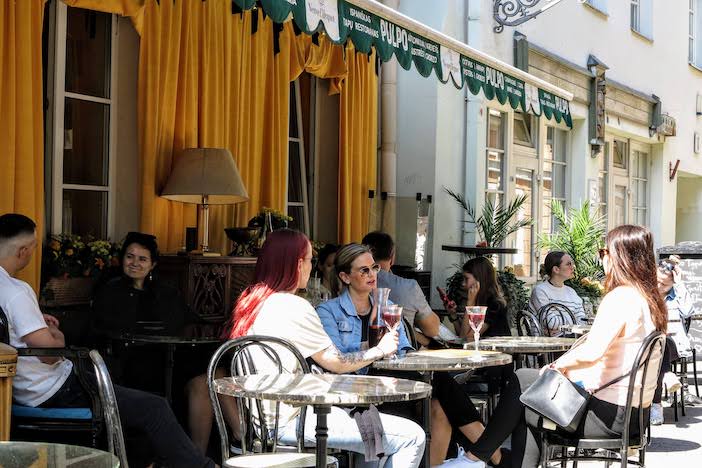
As the sun shines down in the Old Town the next day, people are sitting at pavement tables drinking excellent coffee, and in my case also eating a kind of pasty in Dziuga, a popular snack across town any time of day or night. Bagels are also very popular here, a reminder of the once large Jewish population of Vilnius, remembered today by street names in Hebrew in what was once the Jewish quarter before the Nazis arrived.
Different cultures have all left their mark on the city, in the food and, most obviously, in the division in the city between the eastern side, with its Russian Orthodox churches, and the West’s predominantly Catholic side. All are beautiful and scrupulously maintained. There seems to be almost no litter in Vilnius, while graffiti is confined to those few buildings still awaiting restoration. Locals here do not mess on their own doorstep.
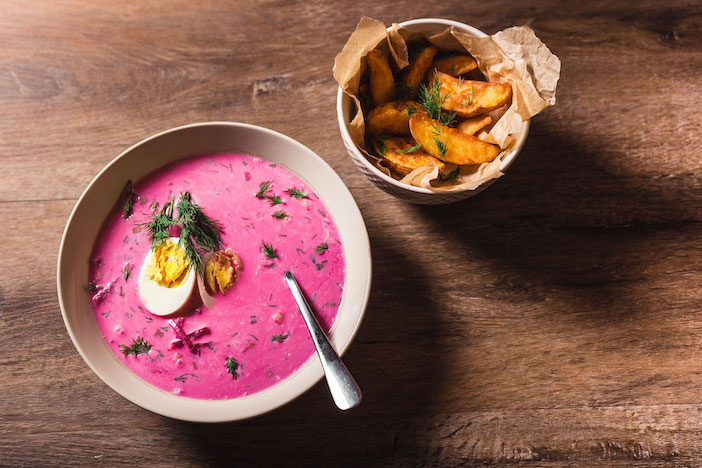
Traditional Šaltibarščiai and fried potatoes (Photo courtesy of Go Vilnius)
One cliche that Vilnius cheerfully embraces, or perhaps gobbles up, though, is Šaltibarsčiai – beetroot soup. Served cold, it’s the traditional dish marking the arrival of the Lithuanian summer, its vivid pink colour lighting up the table and it’s much loved.
I headed out to Bastion Hill to watch Vilnius residents celebrate Beetroot Day with beetroot slides into ‘soup’, and then wandered the town checking out the many places serving their unique takes on the iconic dish. I settled down for lunch at Valdovų sodas where their soup was lighter than most, but all the better for it. The interplay of kefir – fermented cow’s milk – and sweet beetroot, with eggs and pickles was delicious, and it was served, as is traditional, with some fried new potatoes.
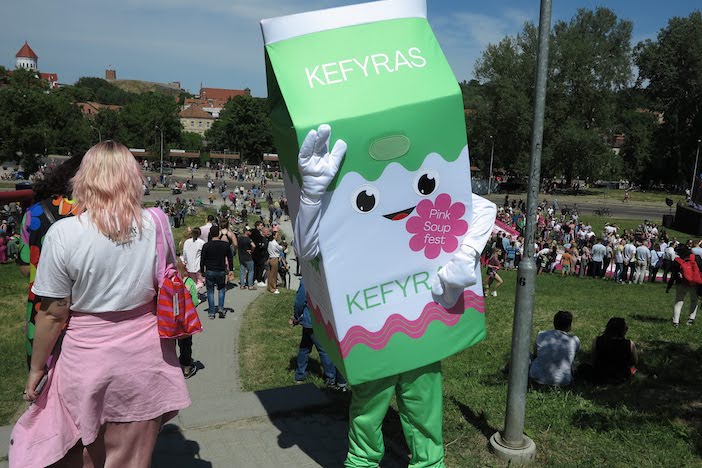
Another traditional dish features deep fried strips of bread, lightly salted, rubbed with garlic and served with grated cheese mixed with mayonnaise. Absolutely delicious, it’s usually served as a starter, or eaten alongside a glass or three of one of Lithuania’s superb beers. The many, many varieties of pickled cucumbers and gherkins are also very good with a beer at any time.
Refreshed, and a little stuffed, I walked it off with a tour of the Old Town, admiring the buildings and street art, and peeking into the many hidden courtyards that conceal cool bars and more enticing places to eat. It’s said that in the old town you could once cross to any point using just the courtyards, avoiding the streets; an ideal way to get around in a city that for a long time was under different unpleasant occupying armies.
Embarking on this city-by-food tour, it must be said that not that every Lithuanian dish is a culinary marvel. In the stylish kitchen/studio/workshop of one Lithuania’s top TV chefs, while learning the art of a classic Šaltibarsčiai, I was also introduced to the famous cepelinai, or Zeppelins, a name derived evidently as much from the way they look as they do leaving you in ruins and praying for death.

Cepelinai, the infamous edible ‘Zeppelins’ (Photo courtesy of Go Vilnius)
Grated raw potatoes – Lithuanians have a special grater for the job – are squeezed hard in muslin until almost bone dry and then mixed with some cooked potato and some of the starch that settles out of the extracted water. This paste is formed into circles of dough which is moulded around a filling of typically meat mince, or cheese – and then said zeppelin is simmered for about twenty minutes.
It’s served immediately, dressed with rendered down bacon bits and sour cream, and I don’t think I ever want to eat one ever again. Declaring this on social media at the time brought the swift disapproval of a friend’s Lithuanian wife back in the UK. She said they were her childhood favourite and revered by all her family, in fact all Lithuanian families. Perhaps so, but not by me.
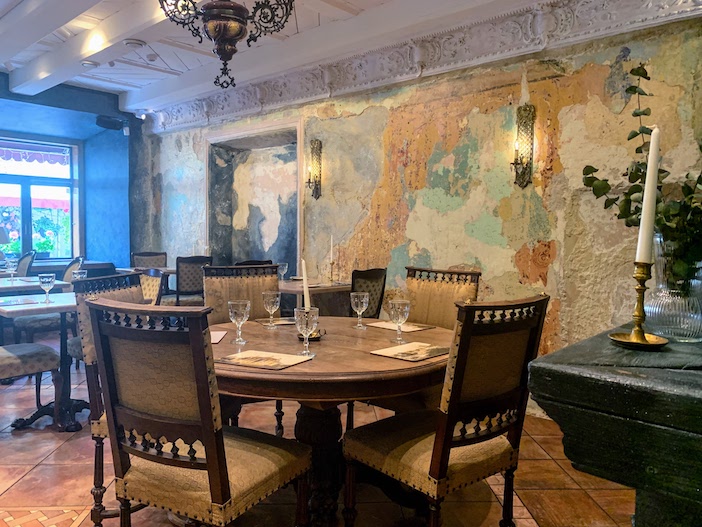
In restaurant Mykos 4, I ate even more traditionally. Tucked down a side street, its authenticity is worn by its 18th Century décor; all heavy wooden furniture and fabric on the walls, and the menu focuses on what bourgeois families would have eaten back in the day, a theme restaurant if you like. A signature dish is whole breaded quail. And, yes, it tastes as Jacobean as it sounds, but was decent enough, particularly when washed down with large quantities of beetroot schnapps, aiding that banquet mood.
Vegetarians are not well represented in the Baltics, and vegans probably don’t exist. In Vilnius’s Hales market – one of the largest and oldest in the city, built in 1906 – stalls are piled high with an incredible variety of smoked meats, a tradition of preserving to store food through harsh winters, alongside plenty of pork fat to reinforce bodies against the cold. Great vats of gherkins, pickled in all kinds of ways, stand next to tables overflowing with seasonal mushrooms, while elderly ladies hawk their wonderful home-sourced honeys, with an incredible variety of flavours, all straight from hives in the forests.
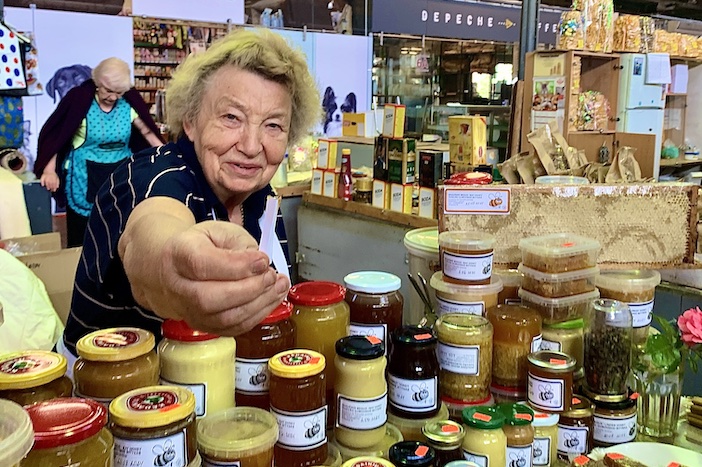
Markets, as ever are a great source of truth for a city’s culinary scene. A table selling all kinds of Russian sauce packets reminds you that free enterprise was not always allowed here. In the market you can also eat directly from a BBQ smoker, or sit and have another beer and a sandwich, and it must be said that Lithuanian bread is perhaps the best I have ever eaten. Stuffed with some local hard cheese, it’s a simple treat.
It’s easy to stereotype Baltic cuisine, I certainly did before I visited, but there’s a whole scene going on in Vilnius, and it’s a beautiful city to enjoy it in. And, armed with the recipe, I am hooked on beetroot soup now and forever.
For more information on Vilnius, including a further insight into its gastronomic scene, and to start planning your trip, please visit the official tourism website at www.govilnius.lt.
Photos by the author, unless otherwise listed

